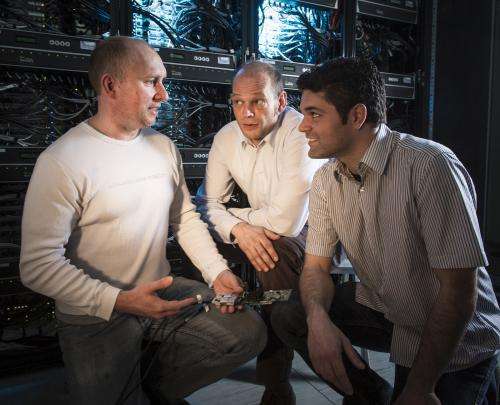Programming model for supercomputers of the future

The demand for even faster, more effective, and also energy-saving computer clusters is growing in every sector. The new asynchronous programming model GPI from Fraunhofer ITWM might become a key building block towards realizing the next generation of supercomputers.
High-performance computing is one of the key technologies for numerous applications that we have come to take for granted – everything from Google searches to weather forecasting and climate simulation to bioinformatics requires an ever increasing amount of computing ressources. Big data analysis additionally is driving the demand for even faster, more effective, and also energy-saving computer clusters. The number of processors per system has now reached the millions and looks set to grow even faster in the future. Yet something has remained largely unchanged over the past 20 years and that is the programming model for these supercomputers. The Message Passing Interface (MPI) ensures that the microprocessors in the distributed systems can communicate. For some time now, however, it has been reaching the limits of its capability.
"I was trying to solve a calculation and simulation problem related to seismic data," says Dr. Carsten Lojewski from the Fraunhofer Institute for Industrial Mathematics ITWM. "But existing methods weren't working. The problems were a lack of scalability, the restriction to bulk-synchronous, two-sided communication, and the lack of fault tolerance. So out of my own curiosity I began to develop a new programming model." This development work ultimately resulted in the Global Address Space Programming Interface – or GPI – which uses the parallel architecture of high-performance computers with maximum efficiency.
GPI is based on a completely new approach: an asynchronous communication model, which is based on remote completion. With this approach, each processor can directly access all data – regardless of which memory it is on and without affecting other parallel processes. Together with Rui Machado, also from Fraunhofer ITWM, and Dr. Christian Simmendinger from T-Systems Solutions for Research, Dr. Carsten Lojewski is receiving a Joseph von Fraunhofer prize this year.
Like the programming model of MPI, GPI was not developed as a parallel programming language, but as a parallel programming interface, which means it can be used universally. The demand for such a scalable, flexible, and fault-tolerant interface is large and growing, especially given the exponential growth in the number of processors in supercomputers.
Initial sample implementations of GPI have worked very successfully: "High-performance computing has become a universal tool in science and business, a fixed part of the design process in fields such as automotive and aircraft manufacturing," says Dr. Christian Simmendinger. "Take the example of aerodynamics: one of the simulation cornerstones in the European aerospace sector, the software TAU, was ported to the GPI platform in a project with the German Aerospace Center (DLR). GPI allowed us to significantly increase parallel efficiency."
Even though GPI is a tool for specialists, it has the potential to revolutionize algorithmic development for high-performance software. It is considered a key component in enabling the next generation of supercomputers – exascale computers, which are 1,000 times faster than the mainframes of today.
Provided by Fraunhofer-Gesellschaft



















